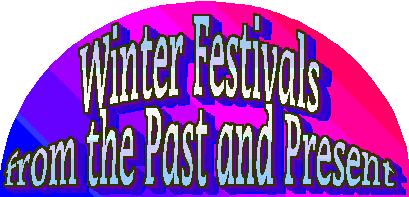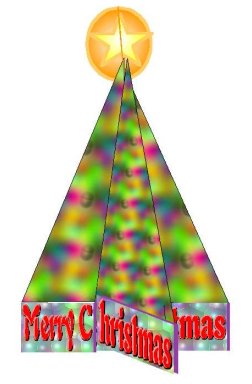 |
. . |
Creat this cute little
tree
for your desk or table.
 Use the full size pattern I have created. Just print, glue, and cut.
Use the full size pattern I have created. Just print, glue, and cut. |


< |

Celebrations during the mid-winter season were common, even before Christmas was celebrated on December 25.Christmas was once a moveable feast celebrated many different times during the year. The choice of December 25 was made by the Pope Julius I in the fourth century AD because this coincided with the pagan rituals of Winter Solstice, or Return of the Sun. The intent was to replace the pagan celebration with the Christian one. In 1752, 11 days were dropped from the year when the switch was from the Julian calendar to the Gregorian calendar. The December 25 date was effectively moved 11 days backwards. Some Christian church sects, called Eastern Orthodox, still celebrate Christmas on January 7 (previously Dec. 25 of the Julian calendar.) Many of the traditions associated with Christmas (giving gifts, lighting a Yule log, singing carols, decorating an evergreen) hark back to older religions. Some traditions described here are reminiscent of modern day customs, and others, like the Festival of the Radishes in Mexico, are bizarre and fascinating. You are invited to explore the rituals of past and present on these pages. |
||

|
||
| A friend from Jacksonville, Florida, says:
Years ago, Dutch child took their shoes off at night and put them on a window sill until they
rose the next morning. On Christmas Eve, they would put hay or straw
in their shoes for the Wise Men's Camels. In turn the Wise Men
(or the 3 King's) would leave treats or small gifts in the shoes.
A similar explanation comes from Burlington, North Carolina: The wooden shoe or "Sabot" was the traditional footwear in many countries. This footwear was great on the farm where the landscape was far from neat and clean. However, the wood in the shoes had to be dried out nightly so children would place the shoes next to the fire place to dry. On Christmas Eve, Pere Noel would place trinkets in the shoes for the good children and a mischievous elf would leave coal in the shoe for bad children. A friend in Loveland, Ohio adds: In Germany, St. Nicholas used to carve toys out of wood and put them in shoes. |
||

|
||
| Before Christianity the Swedish people celebrated
"midvinterblot" at winter solstice. It simply means "mid-winter-blood",
and featured both animal and human sacrifice. This tradition took place
at certain cult places, and basically every old Swedish church is built
on such a place. The pagan tradition was finally abandoned around 1200
AD, due to the missionaries persistence. (Of course they were sacrificed
too, by the Vikings, in the beginning.) Midvinterblot paid tribute to the
local gods, appealing to them to let go of the winter's grip. The winters
in Scandinavia are dark and grim, and these were the days before central
heating. And the Gods were powerful. Until this day Thursday is named after
the war god Thor. Friday after Freja (fertility) It is interesting to note
that to this day the Swedish name for Christmas is Jul (Yule), and the
Jul gnome has a more important role than Christmas father or the Christchild.
You don't kill those pagan tradition easily. The old Viking religion with
Thor and his friends is still practiced by some people, somewhat less bloodily.
(Thank you, Mats, for this fun fact!) |
||
|
||
| Winter Solstice celebrations are held on the eve
of the shortest day of the year. During the first millennium in what is
today Scotland, the Druids celebrated Winter Solstice honoring their Sun
God and rejoicing his return as the days got longer, signaling the coming
of spring. Also called Yule, this tradition still lives today in the Wiccan
traditions and in many cultures around the world.
A huge log -- the Yule Log -- is brought into an outdoor clearing and becomes part of a great bonfire. Everyone dances and sings around the fire. All the noise and great excitement is said to awaken the sun from its long winter sleep, hurrying spring on its way as the cycle begins once again and the days grow longer than the nights. |
||
|
|
||
Full Moons of the MilleniumThe Winter Solstice, the longest night of the year, occurred on December 22, 1999. It was special due to the fact that the solstice will coincide with a Full Moon, and not just any Full Moon. The Moon was within a few hours of its perigee, its closet point to the Earth. This made the Moon appear to be about 14 percent larger than usual. The Moon also was only ten days from the Earth's perihelion, its closest point to the Sun, and since it shines with reflected sunlight, the moon appeared 7 percent brighter than usual. These events occurring together are extremely rare. This was probably be the biggest, brightest Moon of the last Millennium. Rare indeed, since the next time these events coincide is around year 2130. Here's what a friend from Stillwater, Oklahoma, tells me: I sometimes wonder why people are so fancinated with just a full moon and not all the phases. Each on has a significant meaning. I did some research and found that in the year 2000 on the 25th we will have a New Moon, which can be just as beautiful as the stars are easier to see and the moon has nearly disappeared from the sky. Sometimes if you look hard enough you can see the Halo of the Moon during a new Moon: it is beautiful. Moving onward, we get a full moon on the Dec. 26th of 2004, and Dec. 24th 2007. In the Year 2009 on New Year's Eve we get a full moon. Again on Christmas Eve of 2011 we get a full moon and finally in the year 2015 we will get a full moon on Christmas Day. If you'd like to find out when the moon phase occurs on certain date any year any time try using one of two websites. www.sarum.com and http://tycho.usno.navy.mil/vphase.html. |
||
|
|
||

Dosmoche -- Tibetan Celebration of the Dying YearLasting five days, this festival centers around a magical pole covered with stars, crosses, and pentagrams made of string. Dancers dress up in hideous masks to frighten away the evil spirits for the coming year. Feasting and prayers fill the days and the finale is when the pole is torn down by the townsfolk. |
||
|
||
| At one time this was a solemn celebration reenacting the flight of the holy family into Egypt and ending with Mass in the church. The festival became very popular as it transformed into a humorous parody in which the ass was led into the church and treated as an honored guest while the priest and the congregation all brayed like asses. The Church surpressed it in the fifteenth century, although it remained popular and did not die out until years later. | ||
|
||
| La Befana, a kindly witch, rides a broomstick down
the chimney to deliver toys into the stockings of Italian children. The
legends say that Befana was sweeping her floors when the three Wise Men
stopped and asked her to come to see the Baby Jesus. "No," she said, "I
am too busy." Later, she changed her mind but it was too late. So, to this
day, she goes out on Christmas Eve searching for the Holy Child, leaving
gifts for the "holy child" in each household.
A friend from Italy tells us more: In the night between 5 and 6 Jan she rides through the skyes on her broomstick carriyng a big bag on her shoulders. And through the chimneys she delivers fruit and/or sweets to good children and black coal to naughty ones. Real coal has now been replaced by sugary coal (black, white, or coloured). The children hang their stockings on the mantelpiece before going to bed and when they get up thay find out if they've been good or bad over the past year, according to what the stockings have been filled with. |
||
|
||
| To celebrate the New Year in Tibet, Buddhist monks create elaborate yak-butter sculptures depicting a different story or fable each year. The sculptures reach 30 feet high and are lit with special butter lamps. Awards are given for the best butter sculptures. | ||
|
||
| The ancient traditions of Pakistan pre-date the Christian era. During winter solstice, an ancient demigod returns to collect prayers and deliver them to Dezao, the supreme being. During this celebrations women and girls are purified by taking ritual baths. The men pour water over their heads while they hold up bread. Then the men and boys are purified with water and must not sit on chairs until evening when goat's blood is sprinkled on their faces. Following this purification, a great festival begins, with singing, dancing, bonfires, and feasting on goat tripe and other delicacies. | ||
|
||
| Legend has it that the shepherds rejoiced when they learned of the birth of Christ and they waved their hooked staffs about and played Ganna. This is the origin of the game called Ganna that is traditionally played on Christmas Day (January 7 -- the older date of Christmas) by all the men and boys in Ethiopia. | ||
|
||
| This humorous tradition was documented in 1851in
a London Newspaper. In Devonshire, England, on Twelfth Night (January 7),
the farmers get their weapons and go to their apple orchard. Selecting
the oldest tree, they form a circle and chant:
Here's to thee, old apple tree
The men drink cider, make merry, and fire their weapons (charged only with powder) at the tree. They return to the home and are denied entrance no matter what the weather by the women indoors. When one of the men guesses the name of the roast that is being prepared for them, all are let in. The one who guessed the roast is named "King for the Evening" and presides over the party until the wee hours. |
||
|
||
| Here's a fun one to try at your next Christmas Party.
It was popular in England during the 1800's. Set brandy on fire in a bowl.
Throw raisins into the flames. The party guests then take turns snatching
the flaming raisins and popping them into their mouths. The flames go out
as soon as the mouth shuts, so speed and dexterity are essential.
SNAP DRAGON
Here he comes with flaming bowl,
Take care you don't take too much,
With his blue and lapping tongue
For he snaps at all that comes
|
||
|
||
| This unusual event takes place in Oaxaca, Mexico on December 23 each year. It dates to the mid-ninteenth century and commemorates the introduction of the radish by the Spanish colonists. Radishes in this region grow to the size of yams but are not the rounded shape we usually see. They are twisted and and distorted by growing in the rocky soil. These unusual shapes are exploited as local artisans carve them into elaborate scenes from the Bible, from history, and from the Aztec legends. Cash prizes are awarded and the evening culminates with a spectacular fireworks display. | ||
|
||
| This is a Buddhist celebration held on December 8
each year throughout Japan. It is a tradition that has been carried on
since at least 400 AD. Once only observed by tailors and dressmakers, today
anyone who sews participates.
A special shrine is made for the needles containing offerings of food and scissors and thimbles. A pan of tofu (soybean curd) is the center of the shrine and all the broken and bent needles are inserted into it. As the needles go into the tofu, the sewer recites a special prayer in thanks for its fine service over the year. The needles find their final resting place at sea, as devotees everywhere wrap their tofu in paper and launch them out to sea. |
||
|
||
|
Tarjetas Gratis Virtuales,Tarjetas de Feliz Navidad,Tarjetas de Amor Spanish language e-cards for Christmas!
101 Christmas Carols for Christmas e-cards, words to Christmas carols, and more.
Winter Solstice has information on Winter Solstice practices of the past and the present. Card Boulevard Send a free card. Banner proceeds benefit cancer research. The Holiday Spot Funny music and good holiday jokes here. Joseph Campbell Foundation has links on mythology, Indian Gods, Rome, Celtic Culture and more. NORAD tracks Santa has satellite tracking of Santa's sleigh. Starts December 6th!
|
 The Origin of Leaving Gifts inside Shoes
The Origin of Leaving Gifts inside Shoes 
 Kid site
Kid site Fun Santa Site -- jokes, lots of info, and more links.
Fun Santa Site -- jokes, lots of info, and more links.